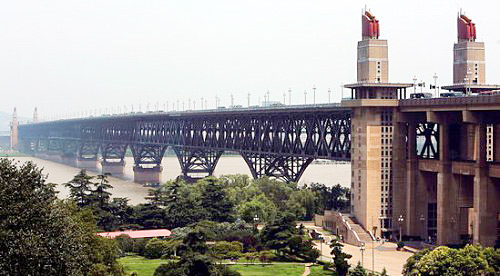|
 |
|
The Nanjing Yangtze River Bridge (PEOPLE.COM) |
In 1949, ferries crossed the Yangtze River at a speed of less than 20 km per hour. By 1969, cars were crossing the Yangtze River via Nanjing City, capital of east China's Jiangsu Province, at a speed of 50 km per hour. Today, cars crossing the Yangtze River zip through the 1,088-meter Sutong Highway Bridge at speeds up to 120 km per hour.
In 2012, the possible speed will increase again when the Beijing-Shanghai Express Railway opens. Trains will cross the Yangtze River through the Nanjing Dashengguan Bridge at speeds up to 300 km per hour, making them like airplanes on wheels.
The changes in the abovementioned figures not only reflect Nanjing's achievements in transportation over the past 60 years, but also manifest its economic growth and comprehensive strength. Nanjing is on its way to becoming a dynamic city.
Rocky road to development
"Shortage of goods" was the major impression shared by older Nanjing citizens in the early days after the founding of the People's Republic of China in 1949. Nanjing's GDP in 1952, for instance, was less than 400 million yuan ($162.6 million), while GDP per capita was only 155 yuan ($63), putting it on par with the world's least developed regions at the time.
The socialist transformation of private ownership of the means of production was successfully conducted in Nanjing before 1957, replaced by a socialist economic system based on public ownership. Nanjing had managed to change from a consumption-oriented city to a production-oriented one, as recorded industrial growth exceeded retail sales growth in the same period.
The "Great Leap Forward" movement from 1958 to 1961 adopted the general line of "going all out, aiming high and achieving greater, faster, better and more economical results in building socialism." Nanjing was no exception, blindly pursuing the alleged "better" results. The three-year natural disaster that accompanied the movement dealt a heavy blow to the local economy.
The economy started to recover in 1965, thanks to the adoption of the national economic policy of "readjustment, consolidation, filling out and improvement," and relevant measures to overcome the economic difficulties since 1961. Unfortunately, the "Cultural Revolution" (1966-1976) brought the bumpy recovery to an abrupt end.
Nanjing has entered the threshold for comprehensive development since the implementation of the nationwide reform and opening-up policy in 1978. In 2008, it ranked fourth in a Forbes magazine list of the top 100 best commercial cities on the Chinese mainland.
A promising future
In recent years, the social security system in Nanjing in the areas of employment, healthcare, education, and housing has gradually improved. In 2008, it was recognized as the city enjoying the highest satisfaction with education quality by Outlook Weekly, a magazine published by the state-run Xinhua News Agency.
Sociologists said there were two reasons for this satisfaction. On the one hand, the city government played a leading role in pushing forward elementary education towards impartiality, all-round development, and innovation. On the other hand, Nanjing was a pioneer in implementing compulsory education free of charge, including financing for children from poor families and free schooling for poor students.
The system of elderly care has also improved significantly. For example, the per capita basic pension of enterprise retirees has grown to 1,540 yuan ($192.5) per month from 676 yuan ($84.4), with a growth rate of 125 percent since 2001, ranking Nanjing first in Jiangsu Province. A new social endowment insurance system and pension subsidy system for rural elderly farmers was introduced in July 2007, aiming to further improve people's livelihood in rural areas.
Environmental protection and greening campaigns have also been carried out since 2000. According to the Nanjing Gardens Bureau, the greenbelt in the urban area has increased by more than 20 million square meters in the past three years. These efforts have paid off, as Nanjing has been named the National Garden City, National Forestation Model City and National Model City for Environmental Protection. At the opening ceremony of the 4th Session of the World Urban Forum in 2008, the Nanjing Municipal Government received a Habitat Scroll of Honor Special Citation from UN-HABITAT.
Nanjing has every reason to be proud of its long history as well as its great potential to be a dynamic city in the future. | 
